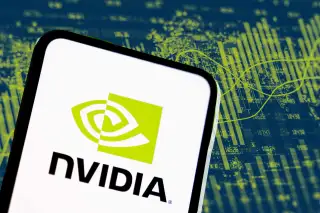Nvidia’s $5 Trillion Valuation Could Pose a Risk to Your Stock Portfolio

Last Wednesday, Nvidia became the first publicly traded company to surpass a $5 trillion market capitalization, renewing concerns about historically high stock valuations amid a growing AI bubble.
The landmark achievement comes after the chip designer joined Microsoft and Apple as the only publicly traded companies with $3 trillion market caps this past June. Then, on July 9, Nvidia became the first-ever $4 trillion market cap company.
Now, just four months later, the semiconductor maker has established the $5 trillion market cap club. That momentum has been fueled by AI's rapid adoption and comes well ahead of the company's Q3 earnings report on Wednesday, Nov. 19, which could propel its shares even higher.
For investors with exposure to Nvidia — through either direct stock ownership or market cap-weighted exchange-traded funds (ETFs) — the news of the company's record-setting valuation is amplifying concerns about concentration risk.
Putting $5 trillion into context
Nvidia has seen its stock gain more than 45% this year, and over the past five years, it's up a notable 1,282.62%. The result of those monumental gains has pushed its market cap — which is determined by multiplying a company's current stock price by its total number of outstanding shares — to stratospheric levels.
Much of that growth has been the result of insatiable demand for Nvidia's essential semiconductors, which is being driven by AI hyperscalers such as Amazon Web Services, Microsoft Azure and Google Cloud Platform.
At the same time, demand from other Big Tech firms outside of AI remains strong. Tesla, for example, uses Nvidia's chips for applications in its autonomous driving technology.
Accordingly, Nvidia is viewed as a lynchpin in every corner of the AI market with the world's three largest asset management firms — Vanguard, BlackRock and State Street — holding a collective 5.12 billion shares.
As the stock continues to be favored by both institutional and retail investors, it's now more valuable than entire sectors of the S&P 500, including utilities, energy, materials and consumer staples — and the collective market caps of every company operating in those respective sectors.
To put $5 trillion into context, it's:
- More than the collective value of the 15 companies that make up Big Pharma
- More than the GDP of every country on Earth except the United States and China
- Equivalent to 10 ExxonMobils, 25 Disneys, 50 Nikes, 96 Ford Motors and 3,311 JetBlues
But as the company's market cap continues to bloat, it's presenting a risk to those with shorter investment horizons.
Nvidia's market cap is a concentration risk
The bigger Nvidia gets, the more concentration risk it poses to the major indices. Nvidia has grown so large that it now accounts for 7.99% of the S&P 500's total weight, while its weighting in the tech-heavy Nasdaq is up to 12.18%.
This means that, even for passive investors who may not directly own the stock, 8 cents of every dollar invested in an S&P 500 index fund is allocated just to Nvidia, while nearly 12 cents of every dollar in a Nasdaq index fund is allocated to the AI giant.
This has raised concerns from even the most ardent tech investors. ARK Invest CEO Cathie Wood told CNBC that she expects AI corrections. But Wood also stopped short of assigning the "bubble" label to the ongoing bull market, despite its gains being driven primarily by members of the Magnificent Seven that have committed enormous capital expenditures to AI.
"I'm not saying there will never be any corrections. Of course there will," Wood said. "But if our expectations for AI... are correct, we are at the very beginning of a technology revolution."
While this may be the beginning of that development, for investors who are nearing or in retirement and don't have enough time to recover from major stock losses, corrections from Nvidia and other companies highly leveraged to AI could face threats to their nest eggs.
"Investing in retirement is a bit more complex, given the variety of potential risks and uncertainties," according to Anil Suri, head of asset allocation and portfolio construction analytics at Merrill Lynch and Bank of America Private Bank.
Older investors can mitigate those risks and uncertainties by seeking out more balanced allocations. That could be accomplished through the use of an equal-weight index fund wherein Nvidia has the same bearing as the smallest company in the S&P 500.
Alternatively, reallocating to lower-risk fixed-income vehicles like bonds and certificates of deposit could help hedge against potential pullbacks.
Importantly, those strategies are particular to investors with shorter horizons. For those with decades ahead of them, maintaining exposure to growth stocks remains the best approach to increasing wealth over the long term.
After all, Nvidia's accomplishment is not an aberration. To quote Warren Buffett, "If a business does well, the stock eventually follows."
More from Money:
Why Investors Are Piling Money Into ETFs at a Record Pace
Forget Stock Picking: 'VOO and Chill' Is Good Enough for This Money Writer
Forget the 'AI Bubble.' Are We Actually in an Everything Bubble?